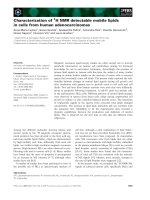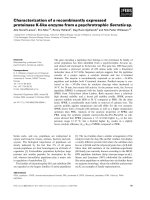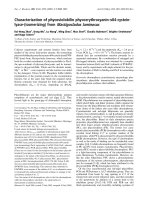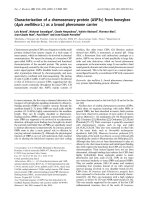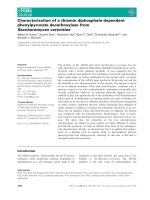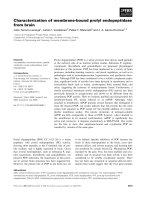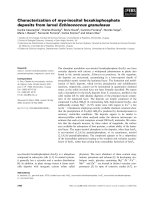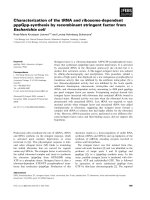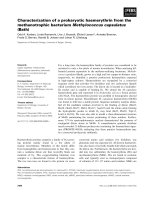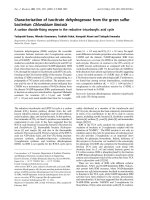Báo cáo khoa học: Characterization of oligosaccharides from the chondroitin/dermatan sulfates 1 H-NMR and 13 C-NMR studies of reduced trisaccharides and hexasaccharides doc
Bạn đang xem bản rút gọn của tài liệu. Xem và tải ngay bản đầy đủ của tài liệu tại đây (230.63 KB, 11 trang )
Characterization of oligosaccharides from the
chondroitin/dermatan sulfates
1
H-NMR and
13
C-NMR studies of reduced trisaccharides and
hexasaccharides
Thomas N. Huckerby
1
, Ian A. Nieduszynski
1
, Marcos Giannopoulos
1
, Stephen D. Weeks
1
,
Ian H. Sadler
2
and Robert M. Lauder
1
1 Department of Biological Sciences, Lancaster University, UK
2 Department of Chemistry, University of Edinburgh, UK
There is considerable interest in the detailed molecular
structure [1,2] and function [3] of glycosaminoglycans
(GAGs) including chondroitin and dermatan sulfate
(CS ⁄ DS) [4–6]. These structurally diverse polymers are
abundant components of extracellular matrices and cell
surfaces in humans and other mammals. Data are
emerging that show roles for CS⁄ DS in a variety of
fundamental biological processes including neurite
Keywords
chondroitin sulfate; dermatan sulfate;
glycosaminoglycan; NMR spectroscopy;
sulfation
Correspondence
R. M. Lauder, Department of Biological
Sciences, IENS, Lancaster University,
Bailrigg, Lancaster LA1 4YQ, UK
Fax: +44 (0)1524 593192
Tel: +44 (0)1524 593561
E-mail:
(Received 21 July 2005, revised 14 Septem-
ber 2005, accepted 7 October 2005)
doi:10.1111/j.1742-4658.2005.05009.x
Chondroitin and dermatan sulfate (CS and DS) chains were isolated from
bovine tracheal cartilage and pig intestinal mucosal preparations and frag-
mented by enzymatic methods. The oligosaccharides studied include a
disaccharide and hexasaccharides from chondroitin ABC lyase digestion as
well as trisaccharides already present in some commercial preparations. In
addition, other trisaccharides were generated from tetrasaccharides by
chemical removal of nonreducing terminal residues. Their structures were
examined by high-field
1
H and
13
C NMR spectroscopy, after reduction
using sodium borohydride. The main hexasaccharide isolated from pig
intestinal mucosal DS was found to be fully 4-O-sulfated and have the
structure: DUA(b1–3)GalNAc4S(b1–4)l-IdoA(a1–3)GalNAc4S(b1–4)l-
IdoA(a1–3)GalNAc4S-ol, whereas one from bovine tracheal cartilage CS
comprised only 6-O-sulfated residues and had the structure: DUA(b1–
3)GalNAc6S( b1–4)GlcA(b1–3)GalNAc6S(b1–4)GlcA(b1–3)GalNAc6S-ol.
No oligosaccharide showed any uronic acid 2-sulfation. One novel disac-
charide was examined and found to have the structure: G alNAc6S(b 1–
4)GlcA-ol. The trisaccharides isolated from the CS ⁄ DS chains were
found to have the structures: DUA(b1–3)GalNAc4S(b1–4)GlcA-ol
and DUA(b1–3)GalNAc6S(b1–4)GlcA-ol. Such oligosaccharides were
found in commercial CS ⁄ DS preparations and may derive from endo-
genous glucuronidase and other enzymatic activity. Chemically generated
trisaccharides were confirmed as models of the CS ⁄ DS chain caps and
included: GalNAc6S(b1–4)GlcA(b1–3)GalNAc4S-ol and GalNAc6S(b1–
4)GlcA(b1–3)GalNAc6S-ol. The full assignment of all signals in the NMR
spectra are given, and these data permit the further characterization of
CS ⁄ DS chains and their nonreducing capping structures.
Abbreviations
CS, chondroitin sulfate; DS, dermatan sulfate; GAG, glycosaminoglycan; GalNAc(-ol), 2-deoxy-2-N-acetylamino-
D-galactose (-galactitol); GlcA,
D-glucuronic acid; GlcA-ol, D-glucuronic acid alditol; IdoA, a-L-iduronic acid; 6S ⁄ 4S, O-ester sulfate group on C6 ⁄ C4; DUA, 4,5-unsaturated
hexuronic acid (4-deoxy-a-
L-threo-hex-4-enepyranosyluronic acid); SAX, strong anion-exchange; SEC, size exclusion chromatography.
6276 FEBS Journal 272 (2005) 6276–6286 ª 2005 The Authors Journal Compilation ª 2005 FEBS
outgrowth [7], disease development [8] and growth fac-
tor binding [9]. CS has also been found in inverte-
brates [10–12] including Drosophila melanogaster [13]
and Caenorhabditis elegans [14], where it has been
shown to have fundamental roles in development [15].
CS ⁄ DS chains comprise a linkage region, a chain
cap and a repeat region [4,5]. The repeat region of CS
is a repeating disaccharide of glucuronic acid (GlcA)
and N-acetylgalactosamine (GalNAc) [-4)GlcA(b1–
3)GalNAc(b1-]
n
, which may be O-sulfated on the C4
and ⁄ or C6 of GalNAc and C2 of GlcA. GlcA residues
of CS may be epimerized to iduronic acid (IdoA)
forming the repeating disaccharide [-4)IdoA(a1–3)Gal-
NAc(b1-]
n
of DS. Thus, CS and DS may be found as
pure polymers or a mixed copolymer in which the DS
residues and GalNAc sulfation isoforms may be
located together in large blocks or distributed through-
out the chain. These will have very different effects on
molecular interactions and biological function.
Both the concentrations and locations of sulfate
ester substituents vary with GAG source [4,16]. For
example, in adult human articular cartilage, extensive
6-O-sulfation of GalNAc is observed ( 95%) [4]. In
shark cartilage, lower levels of 6-O-sulfation are found
( 70%), with 4-O-sulfation making up the balance
along with 25% 2-sulfation of the uronic acid resi-
dues [4], and in tracheal cartilage lower levels of 6-O-
sulfation are found ( 20–40%), with the balance
being mainly GalNAc 4-O-sulfation. In D. melanogas-
ter, 4-O-sulfation, but not 6-O-sulfation, is observed
whereas in C. elegans the chondroitin is unsulfated
[13,14].
Within a tissue, the sulfation profile and levels of
epimerization of GlcA to IdoA change with age. For
example, the level of GalNAc 6-O-sulfation reported
above for human articular cartilage applies only to the
adult; at birth this level is close to zero but rises signi-
ficantly during the first 20 years of life [5,17].
Not only does CS ⁄ DS structure change with tissue
source and age, but within a single chain there is vari-
ability. The chain cap of CS is a GalNAc or GlcA
residue; a 4,6-disulfated GalNAc residue, rare in the
repeat region of human articular cartilage CS, repre-
sents over 50% of the chain caps for a normal adult,
but only 30% at the termini of CS chains from
osteoarthritic cartilage [18,19]. Whereas the CS chain
caps may be highly sulfated, the linkage regions, via
which these pendant polymers are attached to a pro-
tein core, have been shown to exhibit low levels of
sulfation relative to residues within the repeat region
[5,6,20], with preferential localization of unsulfated
and 4-O-sulfated GalNAc residues at linkage regions
[5,6,20].
The overall structure of CS chains is thus highly
complex, showing significant variation in composition
across materials from diverse tissue sources, from
tissues of differing ages and also within a single
chain. Enhanced availability of data to facilitate the
characterization of these structures is therefore of
value.
GAGs are not primary gene products and therefore
their analysis cannot rely on genomic approaches;
structural analysis requires their isolation followed by
a complex characterization process. In our previous
work we have used the paradigm of isolation and
depolymerization of GAG chains to generate oligosac-
charides, the structures of which are determined using
NMR spectroscopy [6,16]. These oligosaccharides are
then integrated into a chromatographic fingerprinting
method which can be used for the analysis of biologi-
cal samples [4].
Chondroitin lyase enzymes are eliminases which
cleave the -3)GalNAc(b1–4)GlcA(b1- ⁄ IdoAa(1- bond
in CS ⁄ DS in the case of chondroitin ABC lyase (EC
4.2.2.4), whereas chondroitin AC lyases act on CS
alone. Chondroitin AC and ABC lyases generate disac-
charides and tetrasaccharides [4] and have been widely
used for the analysis of CS ⁄ DS composition. These
studies have yielded crucial data allowing an under-
standing of species, tissue, age and pathology related
differences and the estimation of changes in CS⁄ DS
abundance and composition. However, the reduction
of the polymer to its individual disaccharide units
removes any possible sequence data that would allow
the reconstruction of biologically important functional
motifs. In addition, the action of chondroitin lyase
enzymes generates a 4,5-unsaturated hexuronic acid
(DUA) from the uronic acid of the cleaved bond.
Thus, the distinction between IdoA and GlcA, epimeri-
zation at C5, is lost and it is impossible to distinguish
between disaccharides derived from DS and those
derived from CS.
We have previously reported
1
H-NMR data for
disaccharides and tetrasaccharides from CS ⁄ DS [16],
and Sugahara et al. [21] have examined, by
1
H NMR
and MS, a series of chondroitin ABC lyase-resistant
fragments derived from CS or DS. Several of these
were trisaccharides, including DUA(b1–3)GalNAc4,
6diS(b1–4)GlcA, terminated by an unreduced GlcA
ring, which could have been derived from polymer
chain-reducing termini by a peeling reaction, or,
through the action of a tissue endo-b-d-glucuronidase.
A series of reduced and unreduced oligosaccharides
obtained from DS were previously characterized by
1
H
and
13
C NMR [22], including the trisaccharide Gal-
NAc4S(b1–4)l-IdoA(a1–3)GalNAc4S-ol.
T. N. Huckerby et al. Chondroitin ⁄ dermatan tri- and hexa-saccharides
FEBS Journal 272 (2005) 6276–6286 ª 2005 The Authors Journal Compilation ª 2005 FEBS 6277
More recently, the preparation and structural char-
acterization of unreduced DS oligosaccharides of up to
dodecasaccharide in size has been discussed [23]; a
combination of 1D and 2D NMR together with elec-
trospray MS was employed.
The employment of nondestructive analytical meth-
ods in the characterization of GAGs is becoming more
important now that full structural information for
large domains is required as part of the examination
of function for these species. Data from other GAG
fragments has already proved valuable in the study of
intact parent polymers; the architecture of keratan sul-
fate chains has been explored in this manner [24,25].
There have already been attempts to examine intact
CS chains isolated from various sources. Considerable
difficulties were met when specific assignments of
structural components were sought. It is thus import-
ant that polymer characterizations should be facilitated
through the availability of comprehensive parameters
describing the structures of a wide range of oligosac-
charide structures. The complete assignments of
1
H
and
13
C NMR spectra from a series of disaccharides
and tetrasaccharides derived from CS ⁄ DS chains have
already been given [16]. In this report we present
1
H-NMR and some
13
C-NMR data for trisaccharides
and hexasaccharides from CS ⁄ DS. These have the
structures shown below:
GalNAc6S(b1–4)GlcA(b1–3)GalNAc4S-ol: CS#604
GalNAc6S(b1–4)GlcA(b1–3)GalNAc6S-ol: CS#606
DUA(b1–3)GalNAc4S(b1–4)GlcA-ol: CS040#
DUA(b1–3)GalNAc6S(b1–4)GlcA-ol: CS060#
GalNAc6S(b1–4)GlcA-ol: CS#60#
DUA(b1–3)GalNAc6S(b1–4)GlcA(b1–3)Gal-
NAc6S(b1–4)GlcA(b1–3)GalNAc6S-ol: CS060606
DUA(b1–3)GalNAc4S(b1–4)l-IdoA(a1–3)Gal-
NAc4S(b1–4)l-IdoA(a1–3)GalNAc4S-ol: DS040404
Results and Discussion
Isolation of oligosaccharides
After depolymerization by chondroitin ABC endolyase,
oligosaccharides are isolated as disaccharides, trisac-
charides, tetrasaccharides and, because of incomplete
depolymerization, as hexasaccharides (Fig. 1) [4,16].
The heterogeneous pools of oligosaccharides generated
in this way were purified by size exclusion chromato-
graphy (SEC) to yield individual oligosaccharides [4,16].
In addition, trisaccharides lacking nonreducing ter-
minal unsaturated uronic acids have been successfully
Fig. 1. Isolation of trisaccharides. Insert: SEC of reduced oligosaccharides generated after depolymerization of bovine tracheal CS chains by
chondroitin ABC endolyase on a Toyapearl HW40s column (50 cm · 1 cm) eluted in 0.5
M ammonium acetate at 0.4 mLÆmin
)1
, the eluate
was monitored by measuring A
232
. Disaccharide and tetrasaccharide pools are indicated by 2 and 4, respectively. Main chromatogram: after
removal of the nonreducing terminal unsaturated uronic acids (Experimental procedures) from the tetrasaccharide mixture (see insert), the
crude trisaccharides were purified by SAX chromatography on a Spherisorb S5 column (25 cm · 1cm)at2mLÆmin
)1
. Bound material was
eluted by a linear gradient of 2 m
M LiClO
4
(buffer A) to 250 mM LiClO
4
(buffer B), pH 5.0, according to the following gradient profile: after a
10-min isocratic phase of 100% buffer A, a gradient of 0–100% buffer B was introduced over 240 min, followed by 10 min of 100% buffer
B. The column eluate was monitored online at 206 nm. Individual fractions were pooled as indicated.
Chondroitin ⁄ dermatan tri- and hexa-saccharides T. N. Huckerby et al.
6278 FEBS Journal 272 (2005) 6276–6286 ª 2005 The Authors Journal Compilation ª 2005 FEBS
prepared from related tetrasaccharides; full
1
H-NMR
and some
13
C-NMR data for these tetrasaccharides
have been reported elsewhere [16].
Trisaccharides
Two trisaccharides were prepared from the correspond-
ing CS repeat unit tetrasaccharides DUA(b1–3)Gal-
NAc6S(b1–4)GlcA(b1–3)GalNAc4S-ol (CST0604) and
DUA(b1–3)GalNAc6S(b1–4)GlcA(b1–3)GalNAc6S-ol
(CST0606) [16] by chemical removal [26] of the unsat-
urated nonreducing terminal residues (Fig. 1). The
1
H-NMR data for these species, designated CS#604
and CS#606, are summarized in Table 1. Partial 600-
MHz gradient-COSY-45 and TOCSY 2D-NMR
spectra for the former are shown in Figs 2 and 3,
respectively, and a partial gradient-COSY-45 spec-
trum for the latter is given in Fig. 4. For both species,
the presence of two anomeric proton sites, together
with two N-acetyl methyl s ignals and the lack of
responses corresponding to DUA protons all confirm
that these are reduced trisaccharides derived from
tetrasaccharides generated by chondroitin ABC
endolyase. CS#604 and CS#606 are confirmed as con-
taining GalNAc4S-ol and GalNAc6S-ol termini,
respectively, through examination of the residue
A (galactosaminitol) chemical shi fts, which clearly
indicate ester sulfate location and have values closely
similar to those found for the corresponding tetrasac-
charides CST0604 and C ST0606 [16]. Similarly, the
internal uronic acid residues (ring B) exhibit shift pat-
terns almost identical with those for GlcUA in the
tetramers. As would be expected, the nonreducing ter-
minal GalNAc6S protons of both species (ring C)
have chemical shift positions that are perturbed from
those fou nd f or t he c orre spo nding site in the DUA-
terminated tetrasaccharides. That for H3 is displaced
by )0.21 p.p.m., together with movements of )0.185
and )0.12 p.p.m., respectively, for H4 and H2. All
other changes are less than 0.04 p.p.m. in magnitude.
Two unusual trisaccharides were isolated after
chondroitin lyase digestion of commercial CS prepara-
tions which are related to CS tetrasaccharides, con-
taining a DUA residue as would normally be
expected, but lacking the N-acetylgalactosaminitol
reducing terminal moiety. These are designated
CS040# and CS060#, respectively, and exhibit the
chemical shift values summarized in Table 2. A par-
tial 600-MHz gradient-COSY-45 NMR spectrum for
CS060# is shown in Fig. 5. Comparisons of chemical
shift values for the DUA residues in repeat-unit tetra-
saccharides show only minor perturbations [16]. For
CS040#, all (ring C) signals fall within 0.02 p.p.m. of
Table 1. Proton chemical shifts for the trisaccharides CS#604 and
CS#606. Shift values are from COSY-45 data except for those
marked with an asterisk (*).
Residue Proton CS#604 (p.p.m.) CS#606 (p.p.m.)
GalNAc (C) H1 4.558* 4.589*
H2 3.917* 3.930*
H3 3.743 3.745
H4 3.988* 4.002*
H5 3.967* 3.976*
H6 4.24 4.24
H6¢ 4.24 4.24
CH
3
2.056* 2.056*
GlcA (B) H1 4.628* 4.556*
H2 3.480* 3.451*
H3 3.638 3.633*
H4 3.77 3.75
H5 3.77 3.75
GalNAc-ol (A)H1 3.70 3.717
H1¢ 3.72 3.784*
H2 4.295 4.390*
H3 4.257 4.077
H4 4.492* 3.570*
H5 4.146* 4.308*
H6 3.705 4.07
H6¢ 3.705 4.09
CH
3
2.018* 2.051*
Fig. 2. Partial 600-MHz gradient-COSY-45 spectrum for CS#604 at
43 °C. The spectral width was 1750.7 Hz, and eight acquisitions for
each of 1024 increments were sampled into 1024 complex points.
The array was zero-filled to 2048 · 2048 complex points and trans-
formed in each dimension after application of a (sinebell)
2
window
function. CS#604 has the structure:
GalNAc6S(b1–4)GlcA(b1–3)GalNAc4S-ol.
CBA
T. N. Huckerby et al. Chondroitin ⁄ dermatan tri- and hexa-saccharides
FEBS Journal 272 (2005) 6276–6286 ª 2005 The Authors Journal Compilation ª 2005 FEBS 6279
the corresponding (ring D) locations for CST0404; in
the case of CS060#, all are within 0.01 p.p.m. of the
shift values seen in either CST0604 or CST0606 with
the sole exception of H3 (+ 0.016 p.p.m. relative to
CST0606).
When the internal GalNAc (ring B) data are exam-
ined, they clearly distinguish between sulfation at C4
for CS040# (H4, 4.649 p.p.m.; H6,6¢ at 3.783 and
3.811 p.p.m.) and at C6 for CS060# (H4, 4.173 p.p.m.;
H6,6¢ at 4.205 and 4.238 p.p.m.), but other signal posi-
tions are strongly perturbed compared with their loca-
tions in the related tetrasaccharides. There is one
further connected set of protons present for both of
these species. This represents a residue consisting of a
nonequivalent methylene group connected to a series
of four further single proton sites. The chemical shift
values found for both CS040# and CS060# are quite
similar, the minor perturbations reflecting the different
influences of 4-sulfated and 6-sulfated neighbouring
rings. This residue is derived from a GlcA ring, which
has been reductively opened by alkaline borohydride
treatment, forming the corresponding glucuronitol.
The methylene proton pair represent the hydrogens at
the reduced C1 site, and the H2–H5 series does not
terminate (as would be the situation for a GalNAc-ol
residue) with a further nonequivalent methylene group
at C6.
Fig. 3. Partial 600-MHz TOCSY spectrum for CS#604 at 43 °C. The
spectral width was 1750.7 Hz, and eight acquisitions for each of
512 pairs of increments were sampled into 1024 complex points
using a mixing time of 70 ms. The array was zero-filled to
2048 · 2048 complex points and transformed in each dimension
after application of a 1.0 Hz exponential window function. CS#604
has the structure:
GalNAc6S(b1–4)GlcA(b1–3)GalNAc4S-ol.
CBA
Fig. 4. Partial 600-MHz gradient-COSY-45 spectrum for CS#606 at
43 °C. The spectral width was 1750.7 Hz, and eight acquisitions for
each of 1024 increments were sampled into 1024 complex points.
The array was zero-filled to 2048 · 2048 complex points and trans-
formed in each dimension after application of a (sinebell)
2
window
function. CS#606 has the structure:
GalNAc6S(b1–4)GlcA(b1–3)GalNAc6S-ol.
CBA
Table 2. Proton chemical shifts for the oligosaccharides CS040#,
CS060# and CS#60#. Shift values are from COSY-45 data except
for those marked with an asterisk (*).
Residue Proton
CS040#
(p.p.m.)
CS060#
(p.p.m.)
CS#60#
(p.p.m.)
DUA (C) H1 5.297* 5.199 –
H2 3.860 3.805* –
H3 3.963* 4.120* –
H4 5.971* 5.884* –
GalNAc (B) H1 4.835* 4.763* 4.696*
H2 4.092* 4.034* 3.912
H3 4.201* 3.978 3.762
H4 4.649* 4.173* 3.996*
H5 3.876 3.968 3.938
H6 3.783 4.205 4.214
H6¢ 3.811 4.238 4.236
CH3 2.113* 2.080* 2.073*
GlcA-ol (A) H1 3.644* 3.679* 3.672*
H1¢ 3.724* 3.762* 3.758
H2 3.903 3.922* 3.917
H3 3.845 3.855* 3.848*
H4 4.154* 4.092* 4.073*
H5 4.247* 4.214 4.201*
Chondroitin ⁄ dermatan tri- and hexa-saccharides T. N. Huckerby et al.
6280 FEBS Journal 272 (2005) 6276–6286 ª 2005 The Authors Journal Compilation ª 2005 FEBS
A novel disaccharide, related to these trisaccharides
has also been characterized, and the chemical shift
data for this species, designated CS#60#, are also sum-
marized in Table 2. In this molecule, the DUA ring is
absent and the presence of GalNAc 6-sulfation is con-
firmed through the presence of H6,6¢ protons at 4.214
and 4.236 p.p.m. The GalNAc H4 response is found at
3.996 p.p.m.; this, together with H3 which is displaced
by over )0.2 p.p.m. relative to the corresponding sig-
nal in CS060#, confirms that the nonreducing DUA
residue, which would have been attached at C3, is no
longer present.
For these novel oligomers,
13
C-NMR data are also
available and are summarized in Table 3. The influence
of the sulfation position on the observed signal posi-
tions within rings B and C is very similar to that
observed previously [16] for the corresponding tetra-
saccharides, as is seen in Table 4 where difference data
are presented together with the calculated values.
The chondroitin A lyase activity, which acts on
bonds containing 4-sulfated GalNAc residues, is an
order of magnitude greater in chondroitin ABC endo-
lyase than the chondroitin C lyase which acts on bonds
containing 6-sulfated GalNAc residues. Thus, during
cleavage, bonds involving a 4-sulfated GalNAc residue
will be cleaved more often, resulting in a predominance
of 4-sulfated GalNAc residues at the reducing terminus
of the resulting oligosaccharides. This significantly
reduces the number of oligosaccharides actually
observed. However, it also means that the oligosaccha-
ride CS#406, found at the chain cap of articular carti-
lage CS [19], is very challenging to produce as the
required tetrasaccharide CS0406 is not abundant after
chondroitin ABC endolyase digestion [4]. Other trisac-
charides generated in this study are chain cap model
structures; these data will aid identification of chain
cap signals in large, or indeed intact, CS ⁄ DS chains.
In addition, trisaccharides may be isolated from
chains that have been partially depolymerized by prior
Fig. 5. Partial 600-MHz gradient-COSY-45 spectrum for CS060# at
43 °C. The spectral width was 1750.7 Hz, and 24 acquisitions for
each of 1024 increments were sampled into 1024 complex points.
The array was zero-filled to 2048 · 2048 complex points and trans-
formed in each dimension after application of a (sinebell)
2
window
function. CS060# has the structure:
DUA(b1–3)GalNAc6S(b1–4)GlcA-ol.
CB A
Table 3. Carbon chemical shifts for the oligosaccharides CS040#,
CS060# and CS#60#.
Residue Carbon
CS040#
(p.p.m.)
CS060#
(p.p.m.)
CS#60#
(p.p.m.)
DUA (C) C1 102.83 104.25 –
C2 71.54 72.60 –
C3 67.51 68.89 –
C4 109.41 110.11 –
C5 147.01 147.62 –
C6 – 172.21 –
GalNAc (B) C1 102.97 103.70 103.81
C2 55.02 54.12 55.27
C3 78.24 82.50 73.86
C4 79.04 70.51 70.49
C5 77.41 75.60 75.49
C6 63.91 70.36 69.91
CH3 25.27 25.30 25.29
C ¼ O 177.79 178.02 –
GlcA-ol (A) C1 65.61 65.46 65.38
C2 74.58 74.78 74.73
C3 73.04 73.16 73.01
C4 82.89 83.16 82.89
C5 76.11 76.59 76.46
Table 4. Carbon chemical shift Dd values between CS040# and
CS060#.
Residue Carbon Calculated (p.p.m.) Observed (p.p.m.)
DUA (C) C1 +1.1 +1.4
C2 +0.9 +1.1
C3 +1.2 +1.4
C4 +0.6 +0.7
C5 +0.4 +0.6
GalNAc (B) C1 +0.6 +0.7
C2 )1.0 )0.9
C3 +4.0 +4.3
C4 )8.9 )8.5
C5 )1.9 )1.8
C6 +6.2 +6.4
T. N. Huckerby et al. Chondroitin ⁄ dermatan tri- and hexa-saccharides
FEBS Journal 272 (2005) 6276–6286 ª 2005 The Authors Journal Compilation ª 2005 FEBS 6281
endogenous glucuronidase activity. It is noteworthy
that the trisaccharides isolated from tissue sources, i.e.
CS040# and CS060#, have only been derived from
commercial samples of CS and not from those pro-
duced in a research laboratory environment, suggesting
that these may not represent major components
in vivo. This suggests that commercial samples of CS
contain significant levels of chains that are not intact
and that do not represent an appropriate material for
the study of intact CS chains.
Hexasaccharides
Although data from disaccharides, trisaccharides and
tetrasaccharides are valuable for the detailed structural
characterizations of unknown segments derived from
the CS families of polymers, there are many important
features that reside within larger oligosaccharide units.
Data are therefore presented in Table 5 giving compre-
hensive
1
H-NMR signal assignments for the primary
reduced hexasaccharide repeat units derived from
chondroitin 6-sulfate and DS polymers, namely
CS060606 and DS040404. In addition, a partial 600-
MHz gradient-COSY-45 NMR spectrum for CS060606
is shown in Fig. 6, and that for DS040404 is shown in
Fig. 7.
Both of the hexasaccharides showed the expected
presence of three N-acetyl methyl singlet resonances.
Other regions of the spectra were complex, but the H1
and H4 sites in the DUA nonreducing terminal rings
(F) were readily assignable; 2D correlations to H2
and H3 indicated that for these unsaturated residues
the observed signal positions were closely similar to
the corresponding ring D values in the tetrasaccharides
CST0606 and DST0404 [16]. In a similar manner, the
positions of signals corresponding to the GalNAc-ol
(residue A) reducing termini are all found to corres-
pond closely to those of the parallel tetrasaccharides
and those for ring B, residing between a uronic acid
and a GalNAc-ol unit in both the tetrasaccharides
and the hexasaccharides, are likewise little perturbed.
The other ring likely to exhibit only small differences
relative to the corresponding tetrasaccharide is E
(C in the smaller oligomer). This is indeed found to
be the case; only for H1 of ring E in CS060606 is
there a relatively strong change, of )0.07 p.p.m., relat-
ive to H1 of ring C in CST0606. For all of the other
ring E signals in both hexasaccharides the movements
are marginal.
The remaining two pairs of residues may now be
assigned; the uronic acids at position D both comprise
a set of five coupled spins. The GalNAc rings located
at C are present as the typical seven-spin systems, and
both are strongly second order, even at 600 MHz,
which is typical for these carbohydrate oligomers.
Rings C and D are located in regions of the hexasac-
charides that are beginning to approximate the envi-
ronments of polymeric chain segments, therefore the
shift values observed are also becoming closer to those
observed in macromolecular species. These are import-
ant data to take forward to the study of intact CS ⁄ DS
chains.
It is becoming clear that a full understanding of the
structure-function relationships of the chondroitin ⁄ der-
matan sulfates will require detailed data on sulfation
Table 5. Proton chemical shifts for the hexasaccharides CS060606,
and DS040404. Shift values are from COSY-45 data except for
those marked with an asterisk (*).
Residue Proton CS060606 (p.p.m.) DS040404 (p.p.m.)
DUA (F) H1 5.193* 5.268*
H2 3.796* 3.843*
H3 4.108* 3.952*
H4 5.885* 5.961*
GalNAc (E) H1 4.593 4.701
H2 4.027 4.066
H3 3.949 4.165*
H4 4.176 4.633
H5 3.996 3.87
H6 4.218 3.80
H6¢ 4.242 3.80
NAc 2.063* 2.123*
UA (D) H1 4.511* 4.886*
H2 3.387* 3.540*
H3 3.587 3.887
H4 3.745 4.115*
H5 3.709 4.728*
GalNAc (C) H1 4.618 4.670
H2 4.031 4.054
H3 3.860 4.024
H4 4.187 4.675
H5 3.984 3.87
H6 4.218 3.80
H6¢ 4.242 3.80
NAc 2.019* 2.082*
UA (B) H1 4.558* 4.975*
H2 3.451* 3.661
H3 3.646* 4.052
H4 3.754 4.132*
H5 3.754 4.634
GalNAc-ol (A) H1 3.718 3.690
H1¢ 3.789 3.722
H2 4.388* 4.260
H3 4.076 4.280
H4 3.573 4.451*
H5 4.300* 4.013*
H6 4.076 3.677
H6¢ 4.085 3.677
NAc 2.054* 2.037*
Chondroitin ⁄ dermatan tri- and hexa-saccharides T. N. Huckerby et al.
6282 FEBS Journal 272 (2005) 6276–6286 ª 2005 The Authors Journal Compilation ª 2005 FEBS
sequence. It is not sufficient to gain data on the
average ratio of 4-sulfation to 6-sulfation in a popula-
tion of chains. It is likely that many functions will be
associated with domains or capping sequences of speci-
fic structure, and further studies of specific oligosac-
charides from CS⁄ DS chains are required to enhance
our understanding of the biological activities of CS
and DS.
Experimental Procedures
Materials
A Mono-Q 10 ⁄ 10 column was from Pharmacia (Uppsala,
Sweden), the Spherisorb S5 SAX column was from Phase
Separations Ltd (Deeside, Clwyd, UK), the Toyapearl
HW-40 s resin was from Anachem (Luton, UK) and the
Bio-Gel P2 resin was from Bio-Rad (Watford, Herts., UK).
Papain was from Sigma Chemical Co. (Poole, Dorset, UK),
chondroitin ABC endolyase (protease free; Proteus vulgaris;
EC 4.2.2.4) was from Seikagaku Corp. (Tokyo, Japan) via
ICN Biomedicals Ltd (High Wycombe, Bucks., UK), and
lithium perchlorate (ACS grade) and piperazine were from
Aldrich Chemical Co. (Gillingham, Dorset, UK). All other
chemicals were of analytical grade.
Isolation of CS from cartilage and DS from lung
CS was isolated from fresh articular and tracheal carti-
lages as previously described [4,5], and DS was isolated
from bovine lung as previously described [22]. Briefly, the
diced cartilage, or lung, was digested by papain (1 U per
100 mg tissue) in 0.1 m sodium acetate, pH 6.8, with
2.4 mm EDTA and 10 mm cysteine HCl, added just
before digestion, for 24 h at 65 °C. The GAGs were pre-
cipitated from the soluble fraction by the addition of
4 vol. ethanol, and the solution was cooled to 6 °C and
allowed to stand overnight. The precipitate was resus-
pended in a minimum volume of 50 mm sodium acetate,
and the CS, or DS, precipitated by the dropwise addition
of 2 vol. ethanol while the solution was stirred. The solu-
tion was again cooled to 6 °C and allowed to stand over-
night before recovery of the CS, or DS, rich precipitate,
which was dialyzed overnight against distilled water and
lyophilized.
The CS, or DS, chains were released from the attached
amino acids by b-elimination with 0.05 m NaOH containing
1 m sodium borohydride at 45 °C for 48 h [27]. The reac-
tion was terminated by the careful addition of 1 m acetic
Fig. 6. Partial 600-MHz gradient-COSY-45 spectrum for CS060606
at 43 °C. The spectral width was 1750.7 Hz, and 24 acquisitions for
each of 1024 increments were sampled into 1024 complex points.
The array was zero-filled to 2048 · 2048 complex points and Fou-
rier transformed in each dimension after application of a 5% offset
(sinebell)
2
window function. CS060606 has the structure:
DUA(b1–3)GalNAc6S(b1–4)GlcA(b1–3)GalNAc6S(b1–4)GlcA(b1–3)GalNAc6S-ol.
FE DC BA
Fig. 7. Partial 600-MHz gradient-COSY-45 spectrum for DS040404
at 43 °C. The spectral width was 1750.7 Hz, and 56 acquisitions for
each of 512 increments were sampled into 1024 complex points.
The array was zero-filled to 2048 complex points in t
2
and Fourier
transformed after application of a 10% offset sinebell window func-
tion. Data were then extended to 1024 points in t
2
by forward lin-
ear prediction with order 12 before application of a 10% offset
sinebell window function, zero filling to 2048 points and Fourier
transformation. DS040404 has the structure:
DUA(b1–3)GalNAc4S(b1–4)L-IdoA(a1–3)GalNAc4S(b1–4)L-IdoA(a1–3)GalNAc4S-ol.
FE DC B A
T. N. Huckerby et al. Chondroitin ⁄ dermatan tri- and hexa-saccharides
FEBS Journal 272 (2005) 6276–6286 ª 2005 The Authors Journal Compilation ª 2005 FEBS 6283
acid, and the solution dialyzed extensively against distilled
water and lyophilized.
Purification of CS/DS on Mono-Q
CS ⁄ DS was separated from any remaining non-GAG
material using a Mono-Q (10 ⁄ 10) column (1 cm · 10 cm)
in a gradient of 2–500 mm LiClO
4
⁄ 10 mm piperazine, pH
5, at a flow rate of 1 mLÆmin
)1
. The elution of bound
chains was monitored online by measuring A
232
.
Depolymerization of GAGs
Aliquots, 1–10 mg, of CS or DS chains were depolymerized
with 1 U per 100 mg chondroitin ABC endolyase at
20 mgÆmL
)1
in 0.1 m Tris⁄ HCl, pH 8, at 37 °C for 15 h.
The enzyme was inactivated by heating at 100 °C for
1 min, and the oligosaccharides generated were reduced by
the addition of 25 mm NaBH
4
.
Isolation of oligosaccharides
Reduced oligosaccharides were subjected to SEC on a
Toyapearl HW40s column (50 cm · 1 cm) eluted in 0.5 m
ammonium acetate at 0.4 mL Æ min
)1
, the eluate being mon-
itored by measuring A
232
. Disaccharides, trisaccharides,
tetrasaccharides and hexasaccharides were separately
pooled as previously described [4], subjected to repeated
lyophilization, and then stored at )20 °C.
The individual oligosaccharides were purified, from the
CS trisaccharide, tetrasaccharide and hexasaccharide pools
recovered after HW40 SEC, by strong anion-exchange
(SAX) chromatography as previously described [6,16,20]. In
each case a 10-mg aliquot of oligosaccharide was resus-
pended in 500 lL2mm LiClO
4
, pH 5.0, and chromato-
graphed on a Spherisorb S5 column (25 cm · 1 cm) at
2mLÆmin
)1
. Bound material was eluted by a linear gradient
of 2 mm LiClO
4
(buffer A) to 250 mm LiClO
4
(buffer B),
pH 5.0, according to the following gradient profile: after a
10-min isocratic phase of 100% buffer A, a gradient of 0–
100% buffer B was introduced over 240 min, followed by
10 min of 100% buffer B. The column eluate was monit-
ored online at 232 nm or, in the case of trisaccharides, at
206 nm. Individual fractions were pooled, desalted by SEC
on a column of Bio-Rad P2 resin (1 · 12 cm) running at
0.4 mLÆmin
)1
and 50 °C, and then lyophilized.
Trisaccharide preparation by chemical removal of
unsaturated chain termini from tetrasaccharides
For removal of the nonreducing terminal unsaturated uronic
acids [26], an aliquot of reduced tetrasaccharide mixture was
incubated at room temperature with 500 lL35mm mercuric
acetate, pH 5, prepared as previously described [26]. After
1 h, excess reagent was removed by mixing with 2 mL
Dowex AG-50X (H
+
form) which had previously been
washed with 5 mL 5% HCl followed by 50 mL distilled
water. The oligosaccharides were separated from the resin
by centrifugation through a 0.45-lm nylon filter, and the
resin was subsequently washed with 2 mL distilled water fol-
lowed by 500 lL1m NH
4
HCO
3
and the sample lyophilized.
The crude trisaccharides were purified by SAX chromatogra-
phy on a Spherisorb S5 column as described above, and the
purified trisaccharides were desalted by SEC on Bio-Gel P2
as described above and then lyophilized.
NMR spectroscopy
Samples were dissolved in 0.5 mL 99.8%
2
H
2
O, buffered to
pH 7 with phosphate (10 mm) and referenced with sodium
3-trimethyl[
2
H
4
]propionate as internal standard. After micro-
filtration through 0.45-lm nylon filters, samples were lyophi-
lized using a rotary concentrator and exchanged several
times with 0.5 mL 99.8%
2
H
2
O and then once with 99.96%
2
H
2
O before final dissolution in 0.7 mL 99.96%
2
H
2
O.
Preliminary
1
H-NMR spectra and all
13
C-NMR spectra
were obtained at 400 MHz (100 MHz for
13
C) on a JEOL
GSX400 spectrometer fitted with a 5 mm probe. For 1D
13
C-NMR spectra, 50 000–250 000 acquisitions were per-
formed, using 60° pulses at 1 s intervals. High-field 1D and
2D correlation (gradient-COSY-45 and TOCSY)
1
H-NMR
spectra were determined at 600 MHz on a Varian Unity
INOVA spectrometer fitted with a 5 mm triple nucleus
probe capable of field-gradient experiments. All spectra
were determined at 43 °C, and
1
H and
13
C chemical shifts
are quoted relative to internal sodium 3-trimethyl-
silyl[
2
H
4
]propionate at 0.0 p.p.m. Experimental details for
2D spectra are given in the legends to the Figures. The
C ⁄ H-correlation
13
C-NMR spectrum was obtained using
similar conditions to those described previously by Huc-
kerby et al. [28–30].
Spectra were reprocessed for presentation using the soft-
ware packages Gifa V4.2 [31], obtained from Dr M A. Del-
suc (University of Montpellier, France), and nmrPipe [32].
Acknowledgements
We thank the Arthritis Research Campaign (arc)
(grant N0528) for support, and the Engineering and
Physical Sciences Research Council are acknowledged
for provision of 600-MHz NMR facilities at the Uni-
versity of Edinburgh.
References
1 Fransson LA, Havsmark B & Silverberg I (1990) A
method for the sequence analysis of dermatan sulphate.
Biochem J 269, 381–388.
Chondroitin ⁄ dermatan tri- and hexa-saccharides T. N. Huckerby et al.
6284 FEBS Journal 272 (2005) 6276–6286 ª 2005 The Authors Journal Compilation ª 2005 FEBS
2 Cheng F, Heinegard D, Malmstrom A, Schmidtchen A,
Yoshida K & Fransson LA (1994) Patterns of uronosyl
epimerization and 4- ⁄ 6-O-sulphation in chondroitin ⁄ der-
matan sulphate from decorin and biglycan of various
bovine tissues. Glycobiology 4, 685–696.
3 Sugahara K, Mikami T, Uyama T, Mizuguchi S, Nom-
ura K & Kitagawa H (2003) Recent advances in the
structural biology of chondroitin sulfate and dermatan
sulfate. Curr Opin Struct Biol 13, 612–620.
4 Lauder RM, Huckerby TN & Nieduszynski IA (2000)
A fingerprinting method for chondroitin ⁄ dermatan sul-
fate and hyaluronan oligosaccharides. Glycobiology 10,
393–401.
5 Lauder RM, Huckerby TN, Brown GM, Bayliss MT &
Nieduszynski IA (2001) Age-related changes in the sul-
phation of the chondroitin sulphate linkage region from
human articular cartilage aggrecan. Biochem J 358, 523–
528.
6 Huckerby TN, Lauder RM & Nieduszynski IA (1998)
Structure determination for octasaccharides derived
from the carbohydrate-protein linkage region of chon-
droitin sulphate chains in the proteoglycan aggrecan
from bovine articular cartilage. Eur J Biochem 258,
669–676.
7 Nandini CD, Mikami T, Ohta M, Itoh N, Akiyama-
Nambu F & Sugahara K (2004) Structural and func-
tional characterization of oversulfated chondroitin
sulfate ⁄ dermatan sulfate hybrid chains from the noto-
chord of Hagfish. Neuritogenic activity and binding
activities toward growth factors and neurotrophic fac-
tors. J Biol Chem 279, 50799–50809.
8 Fried M, Lauder RM & Duffy PE (2000) Plasmodium
falciparum: adhesion of placental isolates modulated by
the sulfation characteristics of the glycosaminoglycan
receptor. Exp Parasitol 95, 75–78.
9 Bao X, Nishimura S, Mikami T, Yamada S, Itoh N &
Sugahara K (2004) Chondroitin sulfate ⁄ dermatan sul-
fate hybrid chains from embryonic pig brain, which
contain a higher proportion of 1-iduronic acid than
those from adult pig brain, exhibit neuritogenic and
growth factor binding activities. J Biol Chem 279, 9765–
9776.
10 Mourao PA, Pereira MS, Pavao MS, Mulloy B, Tollef-
sen DM, Mowinckel MC & Abildgaard U (1996) Struc-
ture and anticoagulant activity of a fucosylated
chondroitin sulfate from echinoderm. Sulfated fucose
branches on the polysaccharide account for its high
anticoagulant action. J Biol Chem 271, 23973–23984.
11 Nader HB, Ferreira TM, Paiva JF, Medeiros MG,
Jeronimo SM, Paiva VM & Dietrich CP (1984) Isola-
tion and structural studies of heparan sulfates and chon-
droitin sulfates from three species of molluscs. J Biol
Chem 259, 1431–1435.
12 Oliveira FW, Chavante SF, Santos EA, Dietrich CP
& Nader HB (1994) Appearance and fate of a beta-
galactanase, alpha, beta-galactosidases, heparan sulfate
and chondroitin sulfate degrading enzymes during
embryonic development of the mollusc Pomacea sp.
Biochim Biophys Acta 1200, 241–246.
13 Toyoda H, Kinoshita-Toyoda A & Selleck SB (2000)
Structural analysis of glycosaminoglycans in Drosophila
and Caenorhabditis elegans and demonstration that
tout-velu, a Drosophila gene related to EXT tumor sup-
pressors, affects heparan sulfate in vivo. J Biol Chem
275, 2269–2275.
14 Yamada S, Van Die I, Van den Eijnden DH, Yokota
A, Kitagawa H & Sugahara K (1999) Demonstration of
glycosaminoglycans in Caenorhabditis elegans. FEBS
Lett 459, 327–331.
15 Mizuguchi S, Uyama T, Kitagawa H, Nomura KH,
Dejima K, Gengyo-Ando K, Mitani S, Sugahara K &
Nomura K (2003) Chondroitin proteoglycans are
involved in cell division of Caenorhabditis elegans.
Nature 423, 443–448.
16 Huckerby TN, Lauder RM, Brown GM, Nieduszynski
IA, Anderson K, Boocock J, Sandall PL & Weeks SD
(2001) Characterization of oligosaccharides from the
chondroitin sulfates.
1
H-NMR and
13
C-NMR studies
of reduced disaccharides and tetrasaccharides. Eur J
Biochem 268, 1181–1189.
17 Bayliss MT, Osborne D, Woodhouse S & Davidson C
(1999) Sulfation of chondroitin sulfate in human articu-
lar cartilage. The effect of age, topographical position,
and zone of cartilage on tissue composition. J Biol
Chem 274, 15892–15900.
18 Plaas AH, West LA, Wong-Palms S & Nelson FR
(1998) Glycosaminoglycan sulfation in human osteo-
arthritis. Disease-related alterations at the non-reducing
termini of chondroitin and dermatan sulfate. J Biol
Chem 273, 12642–12649.
19 Sauerland K, Plaas AH, Raiss RX & Steinmeyer J
(2003) The sulfation pattern of chondroitin sulfate from
articular cartilage explants in response to mechanical
loading. Biochim Biophys Acta 1638, 241–248.
20 Lauder RM, Huckerby TN & Nieduszynski IA (2000)
Increased incidence of unsulphated and 4-sulphated resi-
dues in the chondroitin sulphate linkage region observed
by high-pH anion-exchange chromatography. Biochem J
347, 339–348.
21 Sugahara K, Takemura Y, Sugiura M, Kohno Y, Yosh-
ida K, Takeda K, Khoo KH, Morris HR & Dell A
(1994) Chondroitinase ABC-resistant sulfated trisacchar-
ides isolated from digests of chondroitin ⁄ dermatan sul-
fate chains. Carbohydr Res 255, 165–182.
22 Sanderson PN, Huckerby TN & Nieduszynski IA (1989)
Chondroitinase ABC digestion of dermatan sulphate.
N.m.r. spectroscopic characterization of the oligo- and
poly-saccharides. Biochem J 257, 347–354.
23 Yang HO, Gunay NS, Toida T & Kuberan B., Yu G,
Kim YS & Linhardt RJ (2000) Preparation and
T. N. Huckerby et al. Chondroitin ⁄ dermatan tri- and hexa-saccharides
FEBS Journal 272 (2005) 6276–6286 ª 2005 The Authors Journal Compilation ª 2005 FEBS 6285
structural determination of dermatan sulfate-derived oli-
gosaccharides. Glycobiology 10, 1033–1039.
24 Huckerby TN, Nieduszynski IA, Bayliss MT & Brown
GM (1999) 600 MHz NMR studies of human articular
cartilage keratan sulfates. Eur J Biochem 266, 1174–
1183.
25 Huckerby TN & Lauder RM (2000) Keratan sulfates
from bovine tracheal cartilage structural studies of
intact polymer chains using H and
13
C NMR spectro-
scopy. Eur J Biochem 267, 3360–3369.
26 Ludwigs U, Elgavish A, Esko JD, Meezan E & Roden
L (1987) Reaction of unsaturated uronic acid residues
with mercuric salts. Cleavage of the hyaluronic acid
disaccharide 2-acetamido-2-deoxy-3-O -(beta- d-gluco-
4-enepyranosyluronic acid)-d-glucose. Biochem J 245,
795–804.
27 Carlson DM (1968) Structures and immunochemical
properties of oligosaccharides isolated from pig submax-
illary mucins. J Biol Chem 243, 616–626.
28 Huckerby TN, Brown GM & Nieduszynski IA (1995)
13
C-NMR spectroscopy of keratan sulphates. Assign-
ments for four poly(N-acetyllactosamine)-repeat-
sequence tetrasaccharides derived from bovine articular
cartilage keratan sulphate by keratanase II digestion.
Eur J Biochem 231, 779–783.
29 Huckerby TN, Brown GM, Dickenson JM & Niedus-
zynski IA (1995) Spectroscopic characterisation of disac-
charides derived from keratan sulfates. Eur J Biochem
229, 119–131.
30 Huckerby TN, Brown GM & Nieduszynski IA (1998)
13
C-NMR spectroscopy of keratan sulphates: assign-
ments for five sialylated pentasaccharides derived from
the non-reducing chain termini of bovine articular carti-
lage keratan sulphate by keratanase II digestion. Eur J
Biochem 251, 991–997.
31 Pons JL, Malliavin TE & Delsuc MA (1996) Gifa V4: a
complete package for NMR dataset processing. J Bio-
mol NMR 8, 445–452.
32 Delaglio F, Grzesiek S, Vuister G, Zhu G, Pfeifer J &
Bax A (1995) Nmrpipe: a multidimensional spectral pro-
cessing system based on UNIX pipes. J Biomol NMR 6,
277–293.
Chondroitin ⁄ dermatan tri- and hexa-saccharides T. N. Huckerby et al.
6286 FEBS Journal 272 (2005) 6276–6286 ª 2005 The Authors Journal Compilation ª 2005 FEBS
